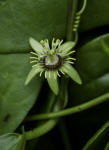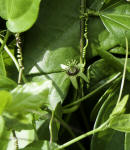Florida's Vines
Corky-stem Passion Vine, Passion Flower Vine, Spurred butterfly-pea, Bay bean, Downy milkpea, Elliott's Milkpea, Hairy Pod Cowpea Vine, Cheese plant
Corky-stem Passion Vine - Passiflora suberosa



Family - Passifloraceae
The Corky-stem Passionvine is a Florida native vine named for the older stems that have a thick "corky" look to them. A low growing, climbing vine with stems 2 or more feet in length. Prefers shady locations but will grow in full sun, often spreading to create large patches.
This passion-vine can be found growing from inland Pineland forests to the hammocks and shell middens near the coast on rich to nutrient poor sandy soils that have a moderate amount of moisture.
Leaves are widely variable in shape, may have entire or lobed margins and are 1 1/2 to 4 inches long with conspicuous glands on the petioles or leaf stems . Flowers are somewhat showy but are small and are a pale greenish to yellowish in color. Fruit is a green, dime sized and many seeded berry, turning bluish-black at maturity. Birds love the fruit and Butterflies including the Florida state Butterfly, the Zebra Longwing use this vine as a larval host plant.
Passion Flower Vine - Passiflora incarnata



Family - Passifloraceae
Habitat - Sunny areas on moist, well drained sandy soils, disturbed sites.
Description - Native perennial vine climbing up to about 10 feet by tendrils, dies to the ground in winter, sending up sprouts from the roots the following spring. One of several Passiflora Spp. which are native to Florida. Leaves are alternate, palmately lobed with 3 and occasionally 5 lobes, leaf margins are serrate. Fruit is a berry, shaped like and about the size of an egg, containing many seeds. Nectar and larval host plant for butterflies including the gulf fritillary and the zebra longwing, Florida's state butterfly.
Flower - Showy, intricate pale lavender flowers 2-3 inches in diameter are produced from spring though summer.
Spurred butterfly pea - Centrosema virginianum
%20Benth)%20_small.jpg)

Family - Fabaceae
Habitat - Open areas of Hammocks, Wet Pinelands, Margins of Wet Prairies on moist sandy soils.
Description - Climbing, twining vine, grows to 6 feet or more in length, trifoliate leaves with lanceolate leaflets. The 1 inch or slightly larger flowers vary in color from lavender to white. Blooms from spring through fall. Fruit is a flattened pod.
Bay bean - Canavalia rosea
_small.jpg)
_small.jpg)
Family - Fabaceae
Habitat - Coastal strand and dunes
Description - Native sprawling or climbing herbaceous vine. Leaves are compound with 3 rounded leaflets, 3-4 inches long.
Flower - Purplish to pinkish-rose colored typical pea-like flowers on long, erect spikes, fruit is a flat pod 4 to 6 inches long. Flowers throughout the year.
Hairypod cowpea, Yellow Vigna - Vigna luteola, Vigna lutea


Family - Fabaceae
Habitat - Tidal flats, Thickets, Tidal Marshes, Flatwoods, disturbed sites.
Native spreading perennial vine, trifolate compound leaves with 3 ovate to linear lanceolate leaflets with an acute apex, very common near the coast growing in mounds. Larval host plant for cassius blue, grey hairstreak, long-tailed skipper and dorantes skipper butterflies, deer often graze on it.
Yellow, 3/4 inch pea-like flowers, blooms year-round, flowers are followed by 2 inch long bean-like seed pods containing several seeds.
Cheese plant - Morinda royoc
_small.jpg)
_small.jpg)
_small1.jpg)
_small.jpg)
Family - Rubiaceae
A woody stemmed, native vine with a spreading shrub-like habit of growth. Found in coastal hammocks & coastal strand habit of the peninsula this plant has a high salt and drought tolerance. Grows in full sun to moderate shade, stemsreach to about 10 feet.
Common names are derived from its fruit which is a syncarp (like a mulberry) and has a cheesy smell when bruised or broken open. Leaves are 4-5 inches long, dark green and primarily obovate in shape with entire margins. Small white flowers with 6 petals are produced year-round, the Cheese plant is a nectar source for many butterflies.
Britton)%20_small.jpg)
Britton)%20_small.jpg)
_small.jpg)